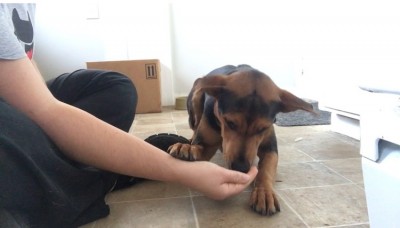by Erica Horn
There are two things that I am passionate about: spreading awareness about Type 1 Diabetes and rehabilitating shelter dogs. Being a Type 1 Diabetic as well as an avid dog lover, it’s no surprise that I have now chosen Diabetes Alert Service Dog trainer as my profession.
I have had Type 1 Diabetes for almost 20 years, and in my mind that makes me about as close to an expert about the disease as I can get without being a medical professional.
Type 1 Diabetes is a metabolic, autoimmune disease in which the body’s inability to produce insulin causes elevated levels of sugar in the bloodstream. When you eat carbohydrates, your body turns them into sugars, or glucose. At that point, your pancreas is supposed to release insulin which serves as a “key” to open your cells to allow the glucose to enter and be used as energy.
Because of the nature of the disease, Type 1 Diabetics have to depend on injecting insulin into their bodies on a daily basis in order to cover the amount of carbohydrates ingested. It’s an exhausting job, and one that is hard to manage. If you don’t dose with enough insulin, your blood sugar will be too high (hyperglycemia), causing headaches, nausea, and over time, slow damage to the body’s organs. If you dose with too much insulin, your blood sugar goes low (hypoglycemia), causing shakiness, sweating, loss of cognitive skills, seizures, and if low enough, even death.
Besides the carbohydrates you eat, almost anything else can affect your blood sugar such as stress, exercise, sickness, or even emotions. On a daily basis I play Russian roulette with death, and all I can do is try to manage as best I can. For us diabetics, our only defense against complications is to test our blood sugar every couple of hours by pricking a finger with a small needle and squeezing a drop of blood onto a test strip in a monitor that detects how much sugar is present in the blood. This needs to happen at ALL hours of the day or night. As you can imagine, many Type 1 Diabetics suffer from all sorts of anxiety, and from a fear that they will go to sleep at night and never wake up because of an undetected extreme low blood sugar that they slept through.
Here is where diabetes alert dogs come into play. These dogs are trained to detect, by scent, and alert their diabetic partner to oncoming dangerously high or low blood sugar episodes that the diabetic cannot feel on their own. After training these dogs for over a year at Early Alert Canines, a non-profit organization dedicated to placing qualified diabetes alert dogs with insulin dependent diabetics, I can personally affirm that they are truly lifesavers! Just by being in close proximity to these dogs and training them how to alert, my own blood sugar levels are the most stable that they have ever been.
It’s pretty intensive work training Diabetes Alert Dogs. At all times of the day I am prepared and ready to train based on what behaviors the dog offers me. If I’m sitting on the couch watching TV and the dog paws at me to alert, no matter how I’m feeling, I have to get up, test, and then reward the dog with a treat if it is correct. Very often, late at night after a busy day, when I finally lie down in bed with a satisfied sigh, I feel the dog pawing my foot. I know I have to get up, address it, and make sure the dog gets a treat for a job well done.
Whenever I am in the car driving with a diabetes alert dog in training, I have to frequently check the rearview mirror to see what it is doing. If it is staring at me intently from the back seat, I know I have to find a safe place to pull over as quickly as possible to make sure my blood sugar isn’t dropping to dangerous levels. Sometime the dog doesn’t catch it and I have to be ready to do some training on the spot before my blood sugar drops any lower. I have to be alert 24 hours a day and be ready to train if the opportunity presents itself. I have to be extremely adept at budgeting my time during the day to make sure I not only get all my daily tasks done, but that I also have the necessary time to train the dogs properly. It’s an exhausting job, and one that is often underappreciated, but it’s something I love doing, because I know from experience how my hard work will make someone else’s life easier later on.
Although I adore training service dogs, my heart has been tugging at me to get back into rescue work. Everyone in the service dog business who I’ve talked with has told me not to utilize shelter dogs as service animals for a number of reasons. Shelter dogs usually have unknown behavioral backgrounds, are often very under-socialized to the human world, and suffer from a plethora of other issues such as anxiety, reactivity, and lack of good manners in the home simply because they’ve never been taught these skills. Basically, most come with too much baggage in order to be properly trained for service work. Most large-scale service dog organizations selectively breed for their service dog candidates; and even then, many of their dogs are dropped.
After doing some research, I did find some organizations out there, like Dogs for the Deaf, and Heads Up Hounds that do currently use shelter dogs for their service dog candidates. I became increasingly hopeful the more research that I did. If other organizations were doing it and being at least somewhat successful, than that meant it might be possible to train rescues as diabetes alert dogs. The more I thought about it, the more I wanted to give it a try.
I began to notice a pattern while training dogs at Early Alert Canines, which was that, while dogs were dropped from the program for various reasons, most typically, it was because of behavioral problems that made them unsuitable for service dog work. Most, if not all, of the dogs that were dropped had already learned how to alert, or showed great promise in alert training. It got me thinking: could I train shelter dogs to be in-home alert dog companions? That way, shelter dogs that already possessed behavior issues outside the home setting, or came with minimal socialization to the human world, would not have issues, as they wouldn’t be expected to be in public settings. Surely there were more Type 1 Diabetics out there like myself who would love to have the support of an alert dog at home, without the responsibility of taking a dog with them everywhere they went.
My next step was to find shelter dogs candidates. I approached Animal Compassion Team of California, an absolutely wonderful non-profit rescue located in Fresno, for whom I had fostered in the past to see if they would be interested in partnering with me on this new adventure. I was overjoyed to find they were just as excited as I to try it out! Long story short, six months, and several candidates later, I have finally found two dogs that I am hopeful can complete the program: Gilligan and Luca. Both are medium-sized, have joyful temperaments, and are eager to learn new things with handlers who they trust and with whom they have a relationship. Both dogs found themselves homeless at Fresno Humane Animal Services before Animal Compassion Team pulled them for rescue at their facility in Fresno. As time goes on, and Gilligan and Luca practice their training, I am encouraged more and more by their progress.
Others in the service dog industry continue to tell me “it can’t be done,” and maybe they’re right. As I test out this pilot program, I keep coming across things that put a wrench in my plans, and I keep having to re-assess my training syllabus to make it work. Luckily, Gilligan and Luca are more than eager to learn new things, and are both progressing well. They have already learned the alert (pawing at their diabetic partner to indicate an out-of-range blood sugar level), and we have moved into the scent training aspect of the program with a vengeance. Currently, both dogs are learning to associate the biochemical scent the diabetic emits during an out-of-range blood sugar episode, to the paw alert that they are learning. Once they are done with their training, I will be looking to place them with an appropriate Type 1 Diabetic. You can follow their progress at www.t1dogs.com, where I will be blogging about their training.
I know it’s going to be a long, hard journey. I know firsthand how life-changing it can be for a diabetic by pairing her or him with a diabetes alert dog. I know for a fact that the dog will save their human partner’s life multiple times over. People keep asking me why I am putting myself through all this time and work for a program that I’m not even sure is going to work. As I see it, if I can give a shelter dog a new purpose in life as well as give a diabetic extra security, than it IS worth my time! Why not save two lives instead of just one?
Video of Gilligan pawing to alert:
Check out more animal rescue stories in our Pet Perspective section and check back every month for another animal rescue adventure from ARF. Advertise in KRL and 10% of your advertising fees can go to a local animal rescue.





















0 Comments